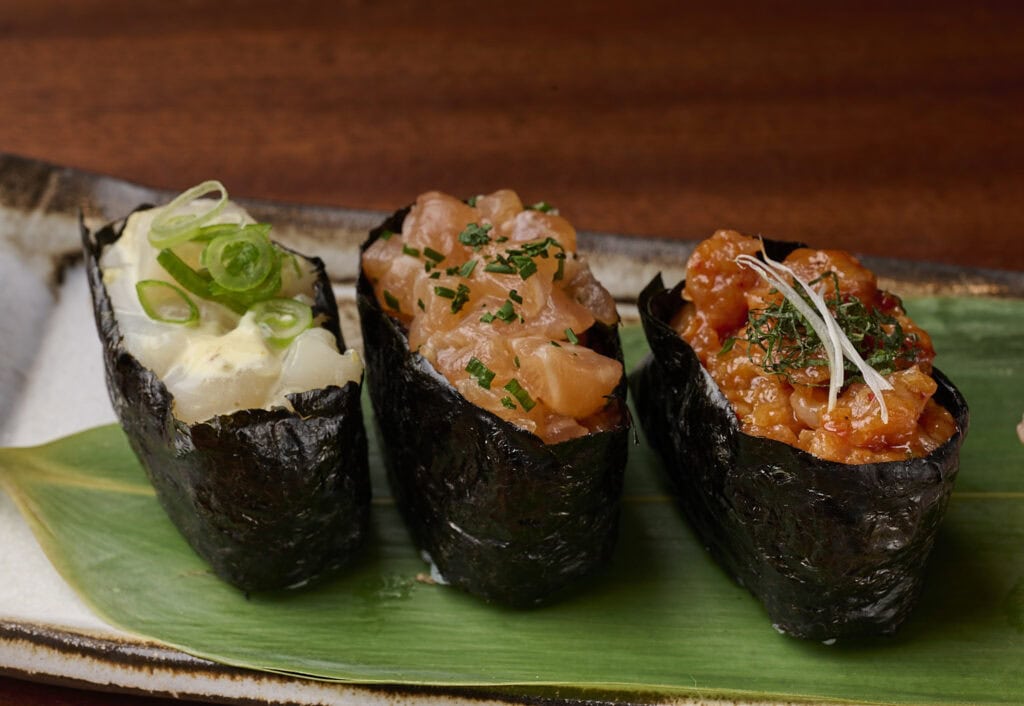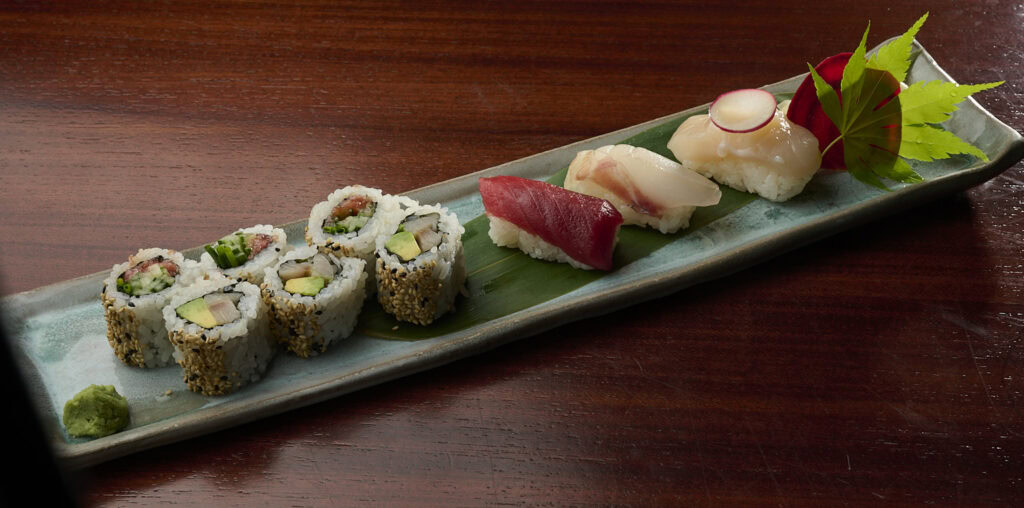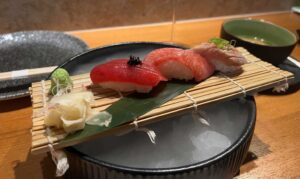Anyone who sits down in a sushi restaurant today, or even just looks at the different types of sushi that defile past the tables on the conveyor belt at Kaiten Sushi, quickly realizes: sushi is not only very colorful, there are also all kinds of varieties and shapes of sushi.
Small rolls, large rolls, sushi rolls that are black on the outside from seaweed and those that are white from rice. Square and oval sushi - even sushi balls.
What shapes and varieties are actually available from Sushi?
The main sushi shapes: Maki and Nigiri
Two forms can be described in advance as typical and the most widespread: Nigiri and Maki.
Sushi is known worldwide as a roll
Sushi in roll form is without doubt the best known worldwide: Maki, Makimono, sushi rolls or sushi rolls.
All different spellings for what has become iconically imprinted as an image: usually a thin black nori skin on the outside, then rice, then fish or vegetables inside.
The typical Japanese Maki are Hosomaki (thin roll), Chūmaki (medium thick roll, relatively rare outside Japan) or Futomaki (thick roll, sometimes also used in Bentō).
Optionally available as outsideroll (also known as inside-out roll or Japanese uramaki), where the nori sheet is flipped over and the rice is on the outside, often decorated with sesame seeds or tobiko ae (fish roe).
If you want to delve deeper, you can find out here everything about Makimono.
The classic sushi form: Nigiri
Nigiri are the shapes that are emblematic of sushi in Japan and are predominantly served in good sushi restaurants.
"Nigiri" has to do with griffin, but in German it does not translate as catchily as the rolls. Nevertheless, more and more gourmets in Germany are realizing why nigiri are by far the most popular in Japan and are considered a kind of classic sushi form: because the fish, its freshness and processing, occupy the central position here.
More about nigiri, whether you should always eat them as a pair, and other questions in our article. "All About Nigiri".
Gunkan: also classic and yet special
When two argue about who is the most famous, the sushi lover is happy about the third: Gunkan.
Sometimes Gunkan are also called "Gunkan-Maki", because here too a nori sheet is wrapped around the outside, as with Makimono. But actually gunkan belong more to the nigiri, to the gourmet sushi always served as single pieces or pairs of two.
In Germany, too, the gunkan, the little battleships, are finding more and more followers. Learn all about Gunkan here.
What are the differences between maki sushi and nigiri sushi?
First, there are the apparent differences between maki sushi (rolled sushi presented as small round pieces) and nigiri sushi (rectangular pieces with toppings).
Somewhat less common is gunkan (coated in dark green nori) and inari sushi, the sweet outlier among sushi varieties. But sushi is so much more!
The dish of leavened rice and fish, seafood and vegetables has evolved over time in Japan. Today, developments are also taking place outside Japan - and as re-imports there, they are always being incorporated into the Japanese sushi tradition.
Overview: These sushi varieties are available
Sushi, especially in Japan, includes much more than just nigiri, maki and gunkan.
There are still numerous forms and special forms, partly regional specialties, partly nationally typical known forms. There are cooked sushi, pressed sushi, historical sushi forms that hardly play a role anymore and seasonal specialties that you should definitely try. Some are for gourmets, some are almost household or bento cuisine.
Here is a table for overview, click on the designations to learn more about the varieties.
| Group | Designation | Kanji | Word- Meaning | Birthplace | Time of birth | Note |
|---|---|---|---|---|---|---|
| Nigiri | 握り | Griffin | Edo (present-day Tōkyō) | 1818-1830 | These types are standard in the vast majority of sushi restaurants throughout Japan | |
| Gunkan | 軍艦 | Battleship | Tōkyō | 1914 | ||
| Makimono 巻物 Rollers | Hosomaki | 細巻 | Thin roll | Edo (present-day Tōkyō) | ~1700 | |
| Chumaki | 中巻 | Medium roll | ? | 1945-1972 | ||
| Futomaki | 太巻 | Thickness roll | Edo (present-day Tōkyō) | ~1700 | ||
| Inari-zushi | 稲荷寿司 | named after Inari, a personification of the rice god or his messenger in the form of a fox | Edo, Nagoya, Toyokawa? | 1853-1868 | ||
| Chirashi-zushi | Nama-chirashi-zushi | 生ちらし寿司 | Raw distributed | Tōkyō | 1868-1912 | The ingredients vary from region to region, but everything is recognized as Chirashizushsofimmediately |
| Gomoku-zushi | 五目寿司 | Mishmash, variety | ? | ? | ||
| Bara-chirashi-zushi | ばら寿司 | In parts | Okayama | 1603-1868 | ||
| Oshi-zushi | Oshi-zushi | 押し寿司 | Pressed | Osaka? | 1336-1573 | Sushi that is known nationwide in Japan, but has a strong regional association with the Ōsaka/Kyōto region. |
| Hako-zushi | 箱寿司 | Box | Osaka | 1887 | ||
| Bō-zushi | 棒鮨・棒寿司 | Stick, rod | Kyōto | 1781 | ||
| Mushi-zushi | 蒸し寿司 | Steam, steamed | Nagasaki or Kyōto, Osaka | 1866 | Regional sushi | |
Regional sushi varieties
Of course, sushi in Japan comes in different regional varieties. The Japanese love nothing more than to travel to all the nooks and crannies of their country and sample the different regional specialties.
You will find a small insight into different, typically regional special forms of sushi in our Regional sushi article.
Historical sushi shapes
Historically, sushi has developed from a way to make the fish last longer. You can find a small overview of different historical forms of sushi in our Articles about historical sushi shapes.
Sushi toppings
What toppings are actually typical for sushi? A little look at historical and contemporary sushi toppings.








